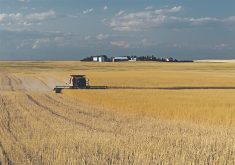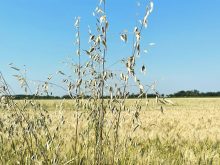The two biggest headwinds facing the Canadian mustard market right now are bigger supplies and weaker demand, market analyst Chuck Penner said at last week’s Sask Mustard annual general meeting in Saskatoon.
“It is really disappointing.”
Related story: New opportunities loom for mustard
Read Also

August rain welcome, but offered limited relief
Increased precipitation in August aids farmers prior to harvest in southern prairies of Canada.
Production of brown and Oriental mustard was down, Penner said, while that of yellow mustard was up about 70 per cent, according to Statistics Canada numbers at the end of the year.
These numbers worked together to balance out carryover supplies from last year, says Penner of LeftField Commodity Research.
“We have some adequate, comfortable supplies of all three classes this year,” he said, estimating total production from last year of around 200,000 tonnes and current supplies of around 265,000 tonnes.
In terms of demand, he said production in the United States was down about one-quarter from the previous year, at 47,000 tonnes, but with a decent sized carryover, he isn’t sure how this will affect global trade.
“Our guesstimate at that they’re looking at a slight contraction in supplies in the U.S. but not adequate for what they’ve done in the past. So, they’re going to still need imports.”
He says there’s also the major question of how trade between the two countries could be affected by a potential tariff.
“Are those imports going to move freely or at an extra price? We’ll maybe see something (soon),” he said Jan. 16.
Russia, which produced about 183,000 tonnes of mustard in 2022, according to the United Nations’ Food and Agriculture Organization, will likely be a less significant competitor this year due to decreased production and yields last year, Penner said.
At the same time, Ukraine is becoming a more significant player, with increased exports last year and likely even more this year.
“I do know from contacts in Ukraine that there has been more interest in growing niche crops like mustard because of all the uncertainty,” Penner said.
“They’re looking for crops specifically that they can export directly into the EU.”
In light of all this, Penner said he’s hoping to see Canada export about 105,000 tonnes of mustard this year, compared to about 90,000 tonnes last year.
“I’m trying to be really optimistic, but it’s not going to be a stellar year for exports.”
Longer term, he says the outlook isn’t much better.
“When you have lows in the mustard market, they’re long lows. I think we’re setting the stage for that same kind of scenario.”
Check out all our 2025 Western Canadian Crop Production Show coverage here.















